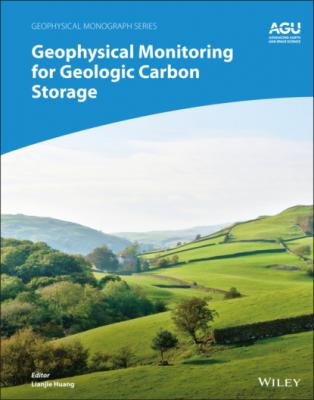Geophysical Monitoring for Geologic Carbon Storage. Группа авторов
Читать онлайн.| Название | Geophysical Monitoring for Geologic Carbon Storage |
|---|---|
| Автор произведения | Группа авторов |
| Жанр | География |
| Серия | |
| Издательство | География |
| Год выпуска | 0 |
| isbn | 9781119156840 |
The total stress in the radial directions ( τ n , τ 11, and τ 22) and the wave‐induced relative fluid displacement (Darcy flux) in the axial direction (w 3) is zero. By introducing these values and equations (5.5)–(5.7) into equations (5.3) and (5.4), we can eliminate all the variables in the ratio between the total stress τ 33 and the axial strain u 3, 3 = ε 33. This ratio, the core‐parallel Young's modulus E para , is given by
Note that this indicates that large fracture compliances result in K * → K U − α 2 M = K D , that is, E para → E D (drained Young's modulus). In contrast, when the fracture compliances are very small, K * → K U and E para → E U (undrained Young's modulus). What this equation reveals is that for large drained normal fracture compliance η D , substitution of fluids within the fracture, which increases η M , may not result in significant changes in the Young's modulus.
Next, we examine the case when a core contains a fracture perpendicular to the axis. The conservation of fluid mass requires
Also, the total stress and Darcy flux in the radial directions ( τ 11, τ 22,w 1,w 2) are zero, and τ 33 = τ n . Similar to the core‐parallel case, using equations (5.3) through (5.6) and equation (5.9), the total stress τ 33 and the total axial strain in the sample
Note that
Equation (5.11) indicates, in contrast with the fracture parallel to the core axis, η M can still have an impact on the Young's modulus of the entire core sample.
Figure 5.8a and b shows predictions for the Young's modulus of the fractured samples during scCO2 injection, based upon equations (5.8) and (5.10), respectively, for a range of η D values. Based upon the CT images of scCO2 distribution from the experiment, the substitution of the fluids was assumed only for the fracture by changing η M as a function of the scCO2 saturation of the entire core. In contrast, for Figure 5.9, the substitution was assumed to happen throughout the sample. The poroelastic parameters of the rock were evaluated from the experimentally determined undrained Young's modulus and shear modulus of the rock at the beginning of the injection experiment, and a mineral bulk modulus of quartz was assumed (K s = 38 GPa). Note that the experimentally determined dry elastic moduli were not used, because saturating the sandstone with water
